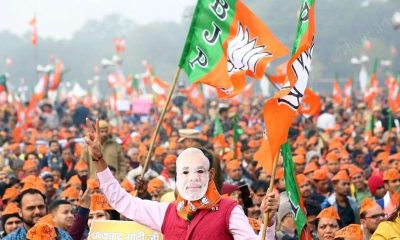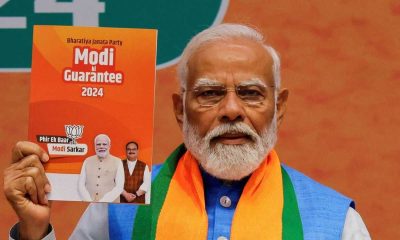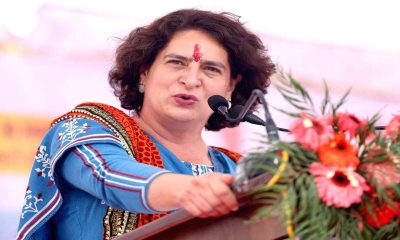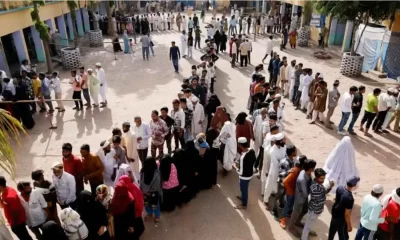India News
AAP to sweep Punjab: Opinion poll
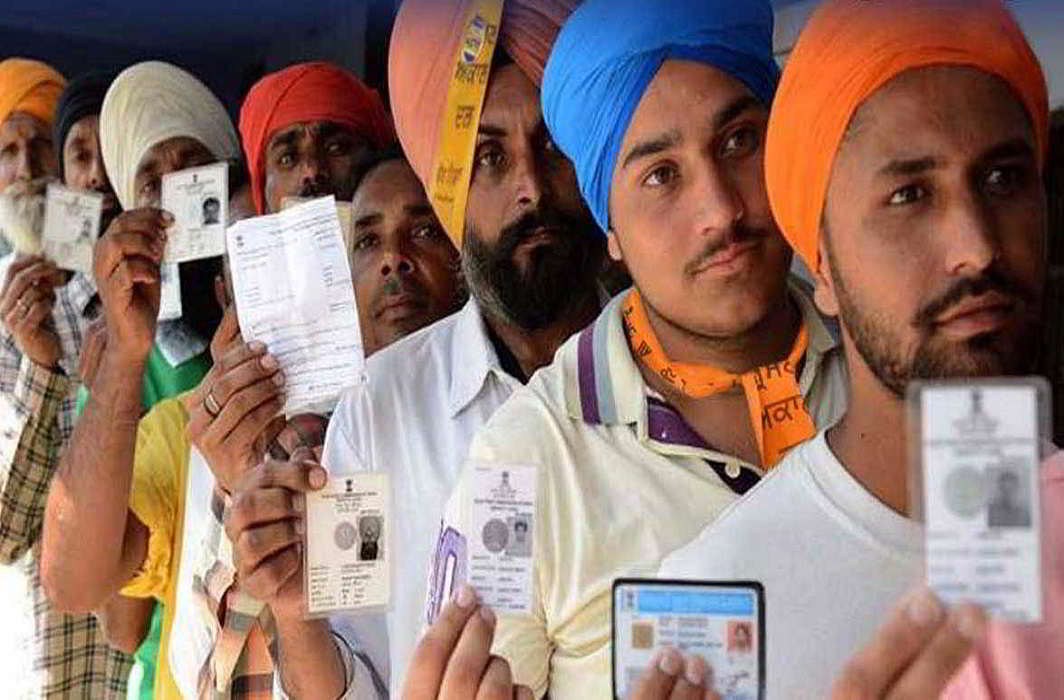
[vc_row][vc_column][vc_column_text]Its results indicate UP heading for a hung assembly, BJP winning Uttarakhand
By Nora Chopra
There are clear indications that no party is likely to get a clear majority in Uttar Pradesh. It looks like it is going to be a hung assembly in the country’s most populous state.
According to an opinion poll conducted by Amrish Tyagi, psephologist and son of Janata Dal (United) general secretary KC Tyagi, in Punjab, Uttar Pradesh and Uttarakhand, before the polling in Punjab and Goa on February 4, the BJP can hope to form government only in Uttarakhand. The projected success of the BJP is imputed to the errors of incumbent Chief Minister Harish Rawat.
Tyagi was a poll consultant with the Donald Trump campaign team and he was tasked to reach out to the Asian community as well as assess its political preferences.
In Punjab where the Aam Aadmi Party had slipped back a few months ago, is back in the race. Arvind Kejriwal’s ‘jharoo’ (the broom is the poll symbol) party is expected to sweep its stronghold, Malwa region, which is represented by its three Members of Parliament (MP)s. Malwa region has 69 seats, out of which, according to the survey, the AAP is expected to get 55 to 62 seats. He would need another 10 to 15 seats from outside Malwa to form the government. The Congress is expected to get 45 to 52, and the Akali-BJP alliance 15 to 18 seats. The others will get two-four seats.
In Sikh-dominated Punjab, the assembly election has been fought for the first time between the poor and the rich. It was a class war, says Tyagi. Kejriwal is supposed to have done what even the founder of Bahujan Samaj Party (BSP), Kanshiram, who belonged to Punjab, could not do. BSP had failed to have any impact in the state which has 34 per cent Dalit population, one of the highest in any state in the country. Kejriwal has successfully wooed Dalit voters along with the rural poor. Polling on Sunday saw the voter turnout in rural areas the highest at any time in the past.
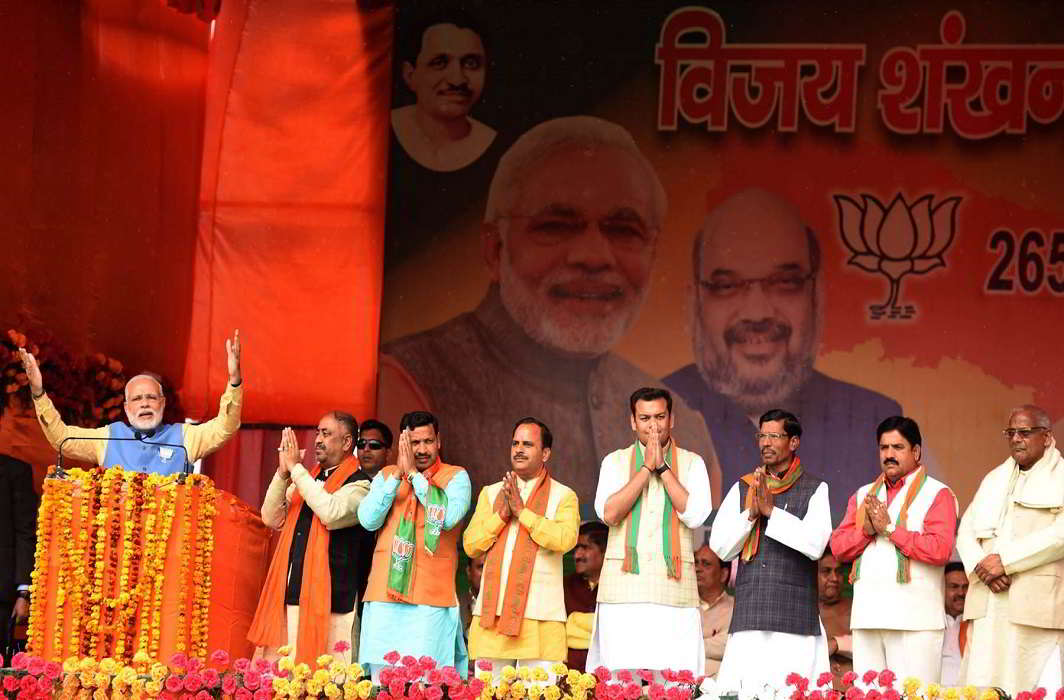
Prime Minister Narendra Modi addresses an election rally in Aligarh on February 5, ahead of the assembly polls in the state, UNI
The Congress was tipped to win in the state this time. Tyagi’s pre-poll survey had given 45 to 52 seats to the party. Captain Amarinder Singh, the Congress’ chief ministerial candidate, faced tough opposition from the Akali candidate and former chief of the army staff (COAS), General JJ Singh, and it is feared that he might even lose the election. Akali chief Prakash Singh Badal, who has been chief minister for 10 years now, has perhaps conceded defeat because he is learnt to have helped the Congress and head of the royal family of Patiala by asking the Akali followers to vote for the Congress candidate.
In this situation, it is the Hindu bloc that has no clear choice. In a normal election, the Hindu voter opted for the Congress and later preferred the BJP. But with the BJP out of reckoning, and the prospects of the Congress looking bleak, the Hindu bloc was left anchorless.
The poll battle in Uttar Pradesh is the most confusing. Tyagi says no party is likely to get a clear majority. According to the survey he had conducted around January 25, the fight in UP is a triangular. It appears that BJP will emerge as the single largest party with 152 to 162 seats, the BSP, the most under-rated party, could win 125 to 135 seats, while the SP-Congress alliance will end in the third spot with 110 to 118 seats. The Congress is likely to fare better than the SP. The others will get 10 to 15 seats.
With each passing day, Tyagi says the scenario appears more confusing than ever. Mayawati seems to be gaining ground by the day.
Much would depend on the first phase of polling in western UP, where the Muslim vote is around 25 per cent and the Dalit vote is about 19 per cent, making her Dalit-Muslim social alliance a formidable force. While the Yadavs are absent in the belt stretching from Saharanpur to Agra. The Congress may boost the staggering fortunes of the SP, but it will not be sufficient for the alliance to win the election in the state. Muslims are unlikely to waste their vote on SP. Their sole aim is to defeat the BJP. The SP and Congress blundered by not aligning with Ajit Singh’s Jat party, the Rashtriya Lok Dal (RLD) for fear of not getting the Muslim votes and apprehensions that the Jat vote would switch to the BJP. But they were wrong as RLD, which had nine seats in the last assembly, is likely to raise it to at least 12 to 14, with Muslims and Jats again coming together. Meanwhile, Mayawati has given 100 tickets to Muslims. She is likely to sweep western UP. In such a scenario, the Congress is unlikely to fare as well as it was expected to do.
In the Yadav belt of central UP, the SP-Congress alliance is likely to do better. But here too, Shivpal Yadav, the disgruntled uncle of the UP CM Akhilesh Yadav, has vowed to take his revenge. He can get the Yadav votes transferred to either the BJP or the BSP. He has already sent many of his followers to BSP, the last one being Mukhtar Ansari. Ansari is strong in east UP, but he can influence Muslim votes all over the state.
The BJP is banking on its traditional upper caste votes in east UP. Here, it will face competition from the Congress, which is working to get back its traditional upper caste votes. The BJP has worked overtime on the non-Yadav Other Backward Classes/Castes (OBC) vote. BJP president Amit Shah and Prime Minister Narendra Modi’s selective attacks on the SP are a strategy to split the Muslim votes, who they think will vote for the SP-Congress. The BJP’s top duo is not attacking the BSP for fear that the Muslims will favour Mayawati.
In Uttarakhand, the BJP has all reasons to be confident. According to Tyagi’s opinion poll the ruling Congress is likely to get 23 to 28 seats, and the BJP 36 to 41 seats. The rest will get three to six seats.
It is the infighting within the party that will cost the Congress dear. Here, it is mainly the Brahmin consolidation which was complete after Narain Dutt Tiwari quit the party to join the BJP, courtesy Chief Minister Harish Rawat. Rawat is alleged to have pushed the Brahmins into BJP, starting with Vijay Bahuguna.
Besides the Brahmin consolidation, the other issue boosting BJP’s fortunes in the hill state is that of the surgical strike. Surgical strike may not help the BJP anywhere but it is supposed to be a big issue in Uttarakhand because every family here has or had a member in the army.
(Views expressed in this article are those of the author, and they do not reflect the stand of this news website.) [/vc_column_text][/vc_column][/vc_row]
2024 Lok Sabha Elections
Lok Sabha Elections: Voter turnout 62.02% in Tamil Nadu till 5pm
The voter turnout in Tamil Nadu stands at 62.02%, while Uttar Pradesh records a turnout of 57.5%. Meanwhile, in West Bengal, voter participation surges to 77.5% as of 5 pm.

The Lok Sabha elections 2024 began today, marking the onset of the world’s largest electoral event. Voting ended in all 39 Lok Sabha constituencies in Tamil Nadu with a total voter turnout of 62.02%. State BJP chief and Coimbatore Lok Sabha constituency candidate K Annamalai said, they were getting complaints from a large number of voters that their names were missing from the voters’ list.
This incident happened in many places. Annamalai said they are demanding re-poll in places where the names of a large number of voters were missing.He said they had a doubt that there was some political interference because the names of a large number of BJP caders were missing from the voters list.
The voters in South Chennai showed lukewarm interest to participate in the election process and had a total voter turnout of 57.04% till 5pm. Although the overall percentage is poor, some areas like Thiruvanmiyur witnessed brisk polling from 7am onwards. Elderly, middle aged and young voters turned up and it was a family outing for many as they cast their vote.
Corporation volunteers assisted senior citizens with wheelchairs and guided them to their respective polling booths. The hot weather also had an impact on the polling as it reduced the voter turnout as many booths in the corporation school in MGR Nagar were seen deserted around noon. Senior citizens showed courage as they reached the polling booths in private vehicles to exercise their franchise.
Most of the polling booths had shamianas for voters so that they could wait in a queue. Some people even found refuge in the nearby buildings to save themselves from the scorching heat. The polling officials gave instructions to the voters to keep their phones switched off while they exercised their franchise. The security personnel at the polling booth also regulated traffic outside the polling booth in MGR Nagar.
2024 Lok Sabha Elections
Deserted by key supporters, the Kamal Nath story looks set to wind to an end in Chhindwara
Nath’s closest allies in his near 50-year reign—Deepak Saxena and Kamlesh Shah—have deserted him. His local team of corporators has also decided to jump ship leaving a gaping hole in Nath’s campaign trail.

By Neeraj Mishra
The Congress has lost Chhindwara only once since Independence when the wily Sunderlal Patwa was sent there by Atal Bihari Vajpayee to test Kamal Nath’s hold on the constituency. Patwa won the 1997 by-election by a slim margin in the backdrop of Nath having forced his wife to first contest and later vacate the seat for him. Nath, however, returned to his winning ways the very next year and has won the seat nine times.
It seems possible that Chhindwara, the lone surviving Congress seat, will be lost again this time and may be forever. A day ahead of polling, the town was drowned in saffron. Not so much the effect of vigorous campaigning by Vivek Sahu of the BJP but the Ram Navami festival which brought out saffron flags on every rooftop. The effect is likely to last since the polling is today. At 77, Nath is unlikely to contest another election here and his son Nakul seems like a pale shadow of his father unable to even make a forceful speech. The days of running Chhindwara from Shikarpur kothi are gone.
Nath’s closest allies in his near 50-year reign—Deepak Saxena and Kamlesh Shah—have deserted him. His local team of corporators has also decided to jump ship leaving a gaping hole in Nath’s campaign trail. Nakul had won by a margin of 37,000 votes in 2019 and the biggest lead had come from Kamlesh’s Amarwada Assembly segment. With Saxena in control of Chhindwara and forced to show his strength in his new party, it is highly likely that Nakul will not be depending on these segments. Instead, the Congress campaign was focused on Pandhurna, Parasia and Chaurai.
Amit Shah was in the region a couple of days ago and warned all BJP workers—old and new—against lethargy. His message was clear, the BJP wants all 29 seats this time. Cabinet Minister Kailash Vijayvargiya is camped here and using all his political acumen for the desired results. One such tactic was to raid the Shikarpur Kothi of Kamal Nath for his assistant Miglani who handles almost everything for him. With Miglani temporarily neutralised, BJP is best placed to repeat its win in Chhindwara in 1997.
2024 Lok Sabha Elections
Lok Sabha Elections 2024: Nearly 40% voter turnout till 1pm
Chennai recorded an average voter turnout of 34% as of 1 pm on Friday. According data released by the Election Commission of India, Chennai (North) recorded 35%, Chennai (Central) recorded 32.3% and Chennai (South) recorded 34%.

The first phase of voting for the 18th Lok Sabha elections started taking place in 21 states and Union territories on Friday. Nearly 40% voter turnout was recorded till 1pm across the states. Seats in Assam, Arunachal Pradesh, Chhattisgarh, Bihar, Maharashtra, Madhya Pradesh, Manipur, Mizoram, Meghalaya, Rajasthan, Nagaland, Tamil Nadu, Sikkim, Uttar Pradesh, Tripura, West Bengal, Uttarakhand, Jammu and Kashmir, Andaman and Nicobar Islands, Lakshadweep and Puducherry go to elections on Friday.
There has been a substantial increase in the voter turnout charts across the Northeast states, with Tripura leading at 53.04% until 1 pm, as per the data released by the Election Commission of India. Other northeast states like Manipur (46.92%) and Meghalaya (48.91%) are also witnessing high voter turnout. After Tripura, West Bengal is experiencing a high voter turnout of 50.96%.
Chennai recorded an average voter turnout of 34% as of 1 pm on Friday. According data released by the Election Commission of India, Chennai (North) recorded 35%, Chennai (Central) recorded 32.3% and Chennai (South) recorded 34%.
Over 33% voter turnout was recorded in the first 6 hours of voting on Friday in 12 parliamentary constituencies of Rajasthan. According to the Election Commission, voting started at 7 am amid tight security arrangements and 33.73 % voting took place till 1 pm. The highest voter turnout of 40.72 % was recorded in the Ganganagar Lok Sabha seat while Karauli-Dholpur saw the lowest turnout of 28.32 %. Jaipur recorded a poll percentage of 39.35 %.
Over 37 % voter turnout was recorded till 1 pm in the Lok Sabha election being held for five parliamentary constituencies in Uttarakhand on Friday. Elections began at 7 am and the five constituencies recorded an overall poll percentage of 37.33 % up to 1 pm. The Nainital-Udham Singh Nagar seat recorded the highest turnout of 40.46 %, followed by Haridwar with 39.41%, Pauri Garhwal with 36.60 %, Tehri Garhwal with 35.29 % and Almora with 32.29 %.
-
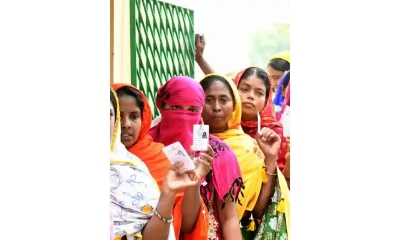
 2024 Lok Sabha Elections17 hours ago
2024 Lok Sabha Elections17 hours agoPrime Minister Narendra Modi urges citizens to vote in record numbers as voting for first phase of Lok Sabha elections begins on 102 seats across India
-

 Entertainment12 hours ago
Entertainment12 hours agoDo Aur Do Pyaar social media review: Social media users say Vidya Balan, Pratik Gandhi deliver standout performances in this adorable film
-
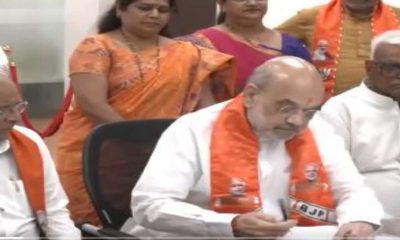
 2024 Lok Sabha Elections13 hours ago
2024 Lok Sabha Elections13 hours agoLok Sabha elections 2024: Amit Shah files nomination from Gandhinagar
-
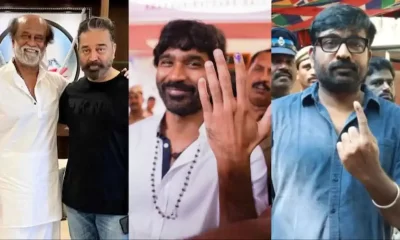
 2024 Lok Sabha Elections16 hours ago
2024 Lok Sabha Elections16 hours agoKamal Haasan, Rajinikanth, Vijay Sethupathi, Dhanush vote in Chennai
-

 Entertainment14 hours ago
Entertainment14 hours agoYami Gautam starrer Article 370 releases on Netflix today
-

 2024 Lok Sabha Elections15 hours ago
2024 Lok Sabha Elections15 hours agoLok Sabha elections 2024: TMC, BJP workers clash in West Bengal’s Cooh Behar ahead of voting
-

 2024 Lok Sabha Elections9 hours ago
2024 Lok Sabha Elections9 hours agoDeserted by key supporters, the Kamal Nath story looks set to wind to an end in Chhindwara
-

 2024 Lok Sabha Elections16 hours ago
2024 Lok Sabha Elections16 hours agoLok Sabha elections 2024: Google Doodle marks the start of polls with index finger voting symbol

